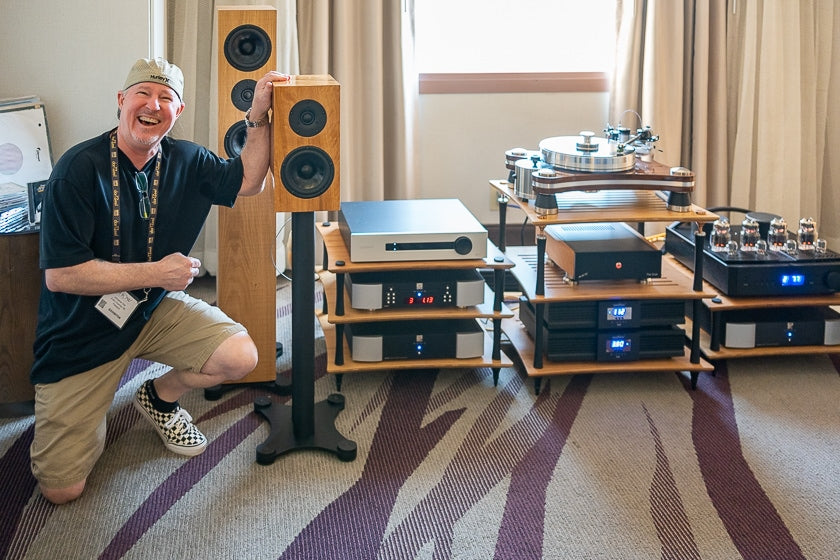One of the first audio shows I attended after what is hopefully the end of the pandemic was T.H.E. Show 2022, held at the Hilton Long Beach Hotel in California in June. This year the show returned with even more energy than in 2021. Last year’s show was partly a trial run after the 2020 lockdown, and with the 2021 show’s success, this year’s was more assured.
I for one was delighted to see the show happen and to see it succeed. In a time period when such respected shows as Rocky Mountain Audio Fest have gone under, seeing T.H.E. Show grow and prosper was reassuring. And like any show with the right management, it was a good time, although the venue in which the show took place underscored how frustrating the Long Beach Hilton can be for exhibitors and management alike. The hotel is in a lovely location near the water, is easy to get to, and is small enough that you don’t feel lost in it. But for whatever reasons they seemed to have staffing problems, which led to delays for the show management in having issues addressed promptly, and I couldn’t help but notice things like overflowing trash bins in the bathrooms.
This show report will be heavy on photos, I am a photographer, after all, but first, some highlights:
Peter Norbaek of PBN Audio held court as one of the first rooms you encountered, with his massive horn-loaded PBN Montana MR!X loudspeakers playing, along with an all-PBN audio chain, as PBN is one of the few companies that makes it all, from restored and enhanced turntables and D/A converters to the loudspeakers – with the exception of cables. The system was wired with Kimber Kable Carbon Series, and Lonny Gould of Kimber was there to happily answer questions and load up the tunes, which ranged from classical to rock and roll and really showed off the advantages of the system. The system utilized the EB-SA monoblock amplifiers, named for legendary designer Erno Borbely, and inspired by a design that Borbely published in a Danish audio magazine in 1981 that Norbaek read as a student.
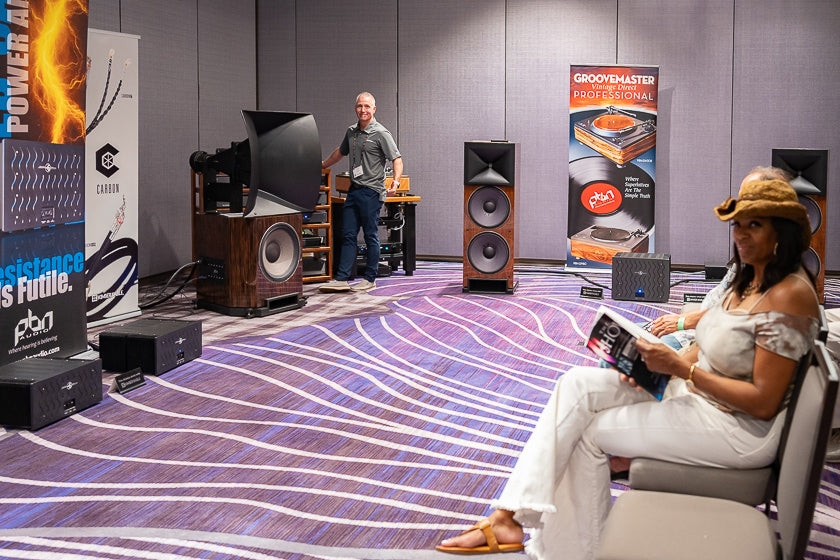
Lonny Gould of Kimber Kable demonstrates the PBN Audio system, which rocked the first floor. Those horns have presence! PBN Montana MR!X loudspeakers, Olympia EB-1 Super Amplifier, Groovemaster Vintage Direct PBN-DN 308 turntable (salvaged from a Japanese broadcast station), Olympia PXIS preamplifier, Olympia LX/is line amp, and Kimber Kable Carbon XL cables.
On the same floor, the JMF Audio room sounded wonderful; musical and articulate, yet effortless when I first walked in. However, the sound became even better after Norman Varney of A/V Room Service, Ltd. placed his EVP (Equipment Vibration Protectors) acoustic isolators under the Zingali Acoustics Client 1.5 EVO speakers. After all these years of being taught to anchor speakers and other electronics to the floor with spikes, Varney’s products demonstrate an effective alternative. The goal of the EVP is to decouple, not encourage coupling.
T.H.E. Show was right-sized to me. Despite being there on all three days that the show was open, I ran out of time to properly sample some of the systems. Some of the rooms, like SVS, drew substantial crowds, which is usual for them. Hearing their subwoofers (which were properly set up of course – subs are an SVS specialty) was a lesson on how low-frequency reproduction should sound. It reminded me of Keith Richard’s quote that if you can’t feel it in your crotch, it’s not rock and roll. Their room rocked.
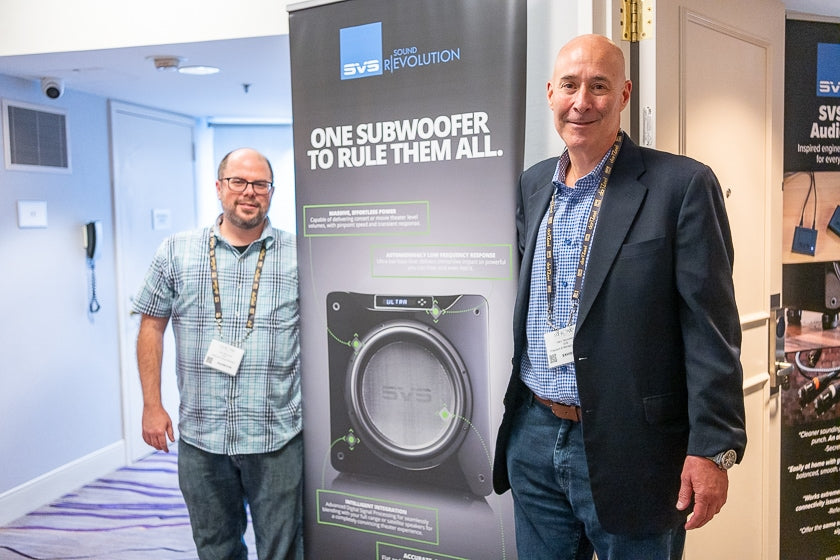
Larry McGough and Gary Yacoubian of SVS had one of the most popular rooms.
While most attendees visit shows to listen to music and geek out over gear, many of my favorite moments at happen during the seminars, and T.H.E. Show organized a serious set of lectures from a variety of folks. At the top of my list was the panel on mastering, featuring Kevin Gray (Cohearent Audio) and Mitch Anderson (eCoustics) discussing the challenges of mastering, with moderator Scott Lylander (T.H.E. Show) keeping things are track. The room was packed and the presentation was engaging. Included is a group photo if you need proof.
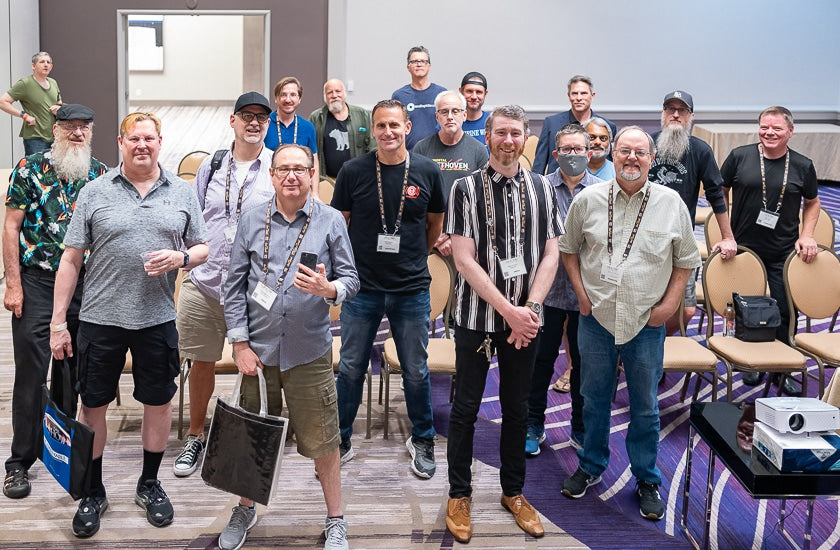
A large crowd attended the lecture by Kevin Gray (Cohearent) and Mitch Anderson (eCoustics), who discussed the challenges of mastering with moderator Scott Lylander (T.H.E. Show).
Jamie Howarth, of audio restoration specialists Plangent Processes, and one of the best-known engineers in the field, was in the audience and joined in the discussion. For me, these are incredibly important events, as they strip away the “noise” from the legions of folks who claim they have expert knowledge when they really don’t. Here, we had the folks who work with master tapes, explaining the actual facts of the projects they’ve worked on. I’m a huge believer in provenance, owing in part to my past professorial role as a photo historian, so hearing the people who have actually worked with original master tapes is a gift to history.
T.H.E. Marketplace had a variety of vendors. Charles Kirmuss was there describing the ins and outs of cleaning LPs (and gave a presentation on the subject during the show). I enjoyed meeting a young man, the friendly Andy George, whose company, Toxic Toast Records of Long Beach, CA had a superb display of rare LPs, and talked about them with passion. There was a positive energy in the room, with headphones, audio components, records, accessories, and more for visitors to peruse.
J.R. Boisclair of WAM Engineering, maker of WallyTools, shared a booth with Norman Varney, who had set up demonstrations of the effectiveness of his acoustical isolation products. I’ve reported on this in previous articles on last year’s T.H.E. Show and Capital Audiofest, and talked about the logic in how they work by preventing any resonances from your room from affecting the sound. It simply never made sense to me to bolt or attach resonance-producers like speakers to an even larger resonator, like your floors, especially if you have wood floors like mine. Why not isolate the speakers from the floor? Which is precisely Varney’s point.
For those who may be unfamiliar with WallyTools, the company offers a wide range of cartridge setup tools and services, and J.R. went into detail about how they work during his seminar at T.H.E. Show. This isn’t a service aimed at Crosley owners; Boisclair works on top-grade cartridges.
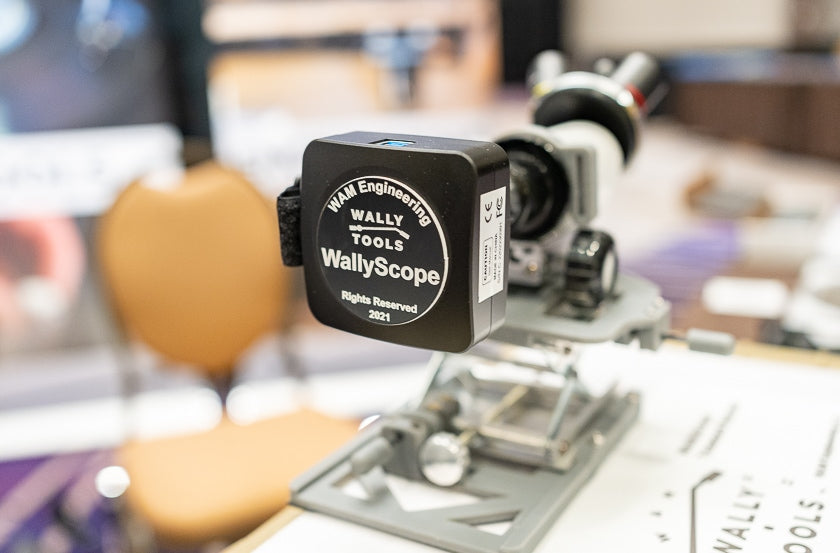
The WallyTools WallyScope. from WAM Engineering, used to analyze phono cartridges.
Getting back to Peter Norbaek: the fact that a long-ago magazine article would prove an inspiration to Norbaek’s current design compelled me to think about the influence that the do it yourself (DIY) sensibility has had on audio. In the golden age of high-fidelity, you could build audio components from companies like Dynaco, Heathkit and Eico, and plans for speakers were published in audio and DIY-oriented magazines. Will that sensibility continue into the future?
It’s true, one can purchase a slew of modules, boards, and parts, but will we continue to see future generations of audio tinkerers arise? One clue might be the popularity of Parts Express, or other vendors of raw speaker drivers. One difference between yesterday and today is perhaps the rise of digital, which isn’t easily tinkered with, but analog is still a wide-open area for exploration. I just really dig the idea that Norbaek, as a kid, read a magazine article and all these years later, he’s making a no-compromise version of a similar amp. Our editor Frank Doris reminded me that the Parts Express booth at AXPONA was crowded, so perhaps we have nothing to worry about.
Although, as most do it yourself types who decided to start an audio company know, the easiest way to make a million dollars in audio is to start with five million dollars.
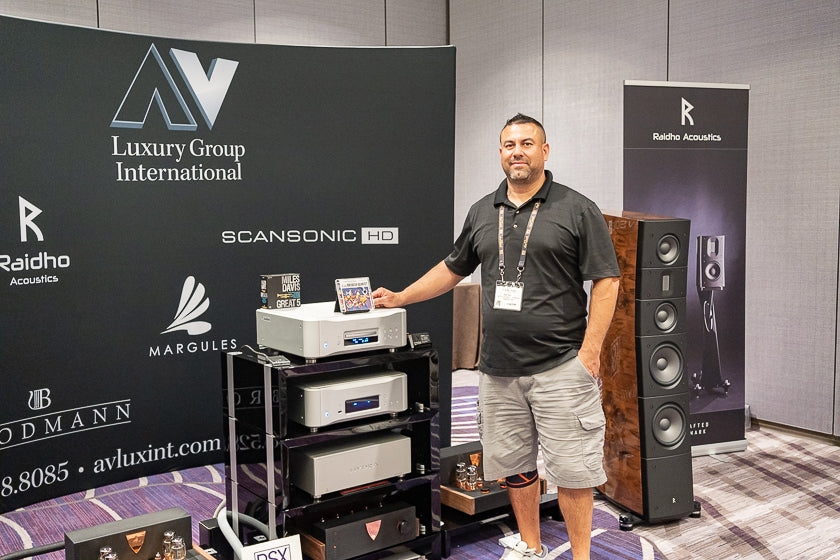
Mike Jaramillo of A/V Luxury Group International. The room featured Esoteric Audio electronics, RSX Technologies cables, Raidho Acoustics speakers, and a Margules i240 pure Class A integrated amp, prototype music server, FZ47DB phono stage, BTV-4 Bluetooth receiver, and QR-2 power conditioner.
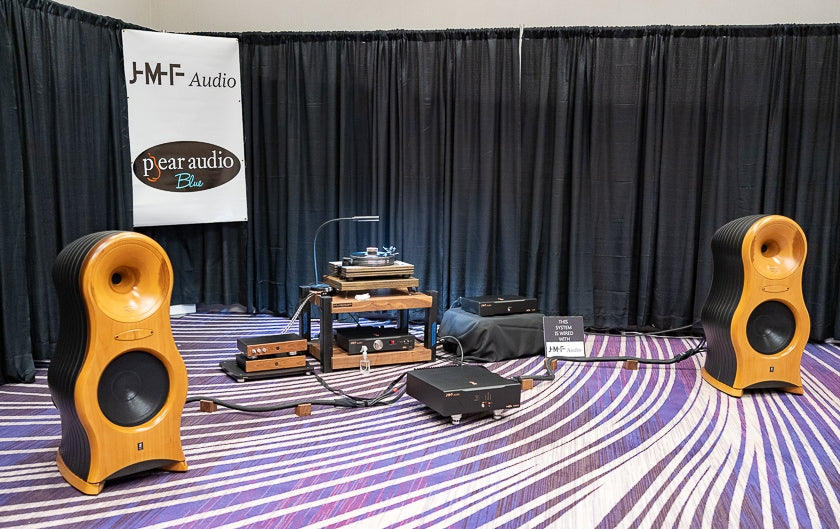
The Reference Components Ltd. room, US distributor for Zingali Acoustics. The Zingali Client 1.5 EVO speakers, JMF Audio, and Pear Audio system proved a popular room, with an open, airy, and precise audio footprint. These speakers labels are blank, to be engraved with the owner’s name upon purchase.
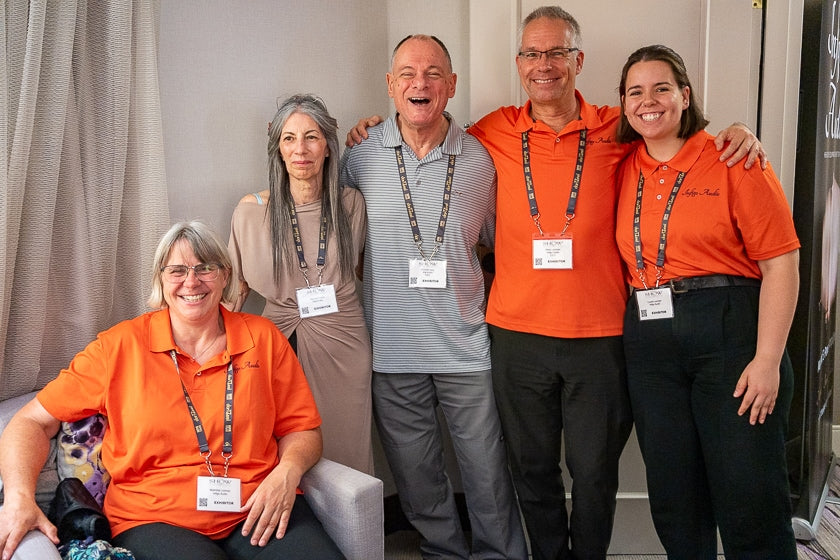
The Infigo Audio room was full of family warmth. Here’s Mathilda Looman (Infigo Audio), Maryann and Michael Levy (Alta Audio), and Hans and Louise Looman (Infigo Audio).
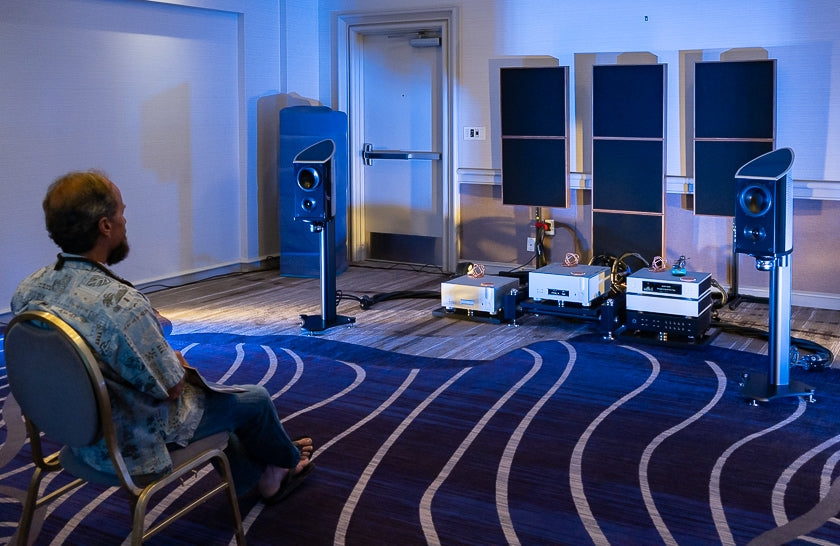
Aaudio Imports boasted an impressive array of gear: the Aurender N30SA music server/streamer and MC20 master clock; HB Design PowerSlave Marble MKII power distributor; Stacore CLD isolation feet; Stage III cables; Wilson Benesch Discovery II loudspeakers and R1 Carbon rack, and a Ypsilon Phaethon integrated amplifier.
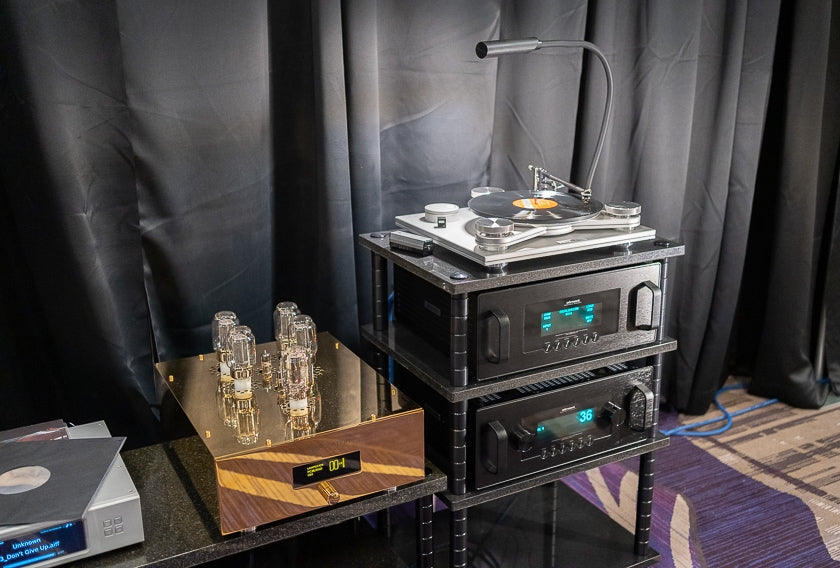
The LampizatOr room featured the buzzworthy Pacific DAC, paired with Audio Research electronics.
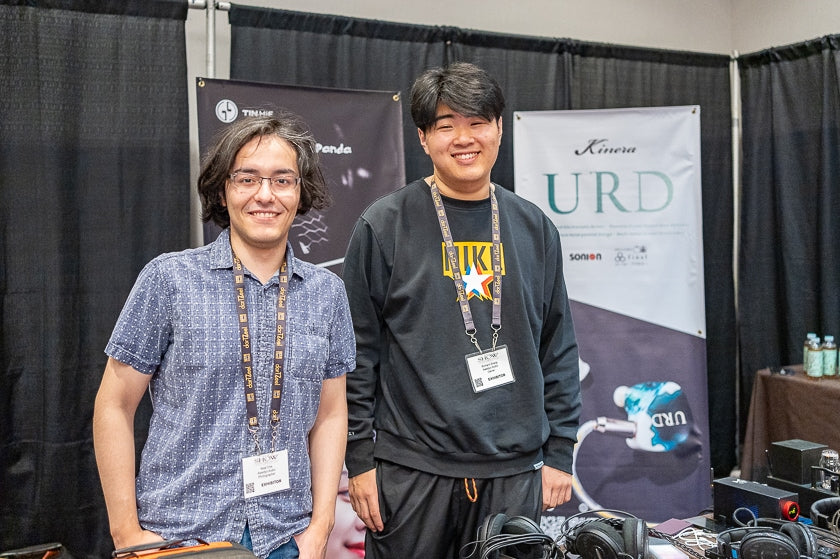
Neal Cha and Richard Zhang of Awedyo Audio, makers of headphones, headphone DACS and amplifiers, and accessories.
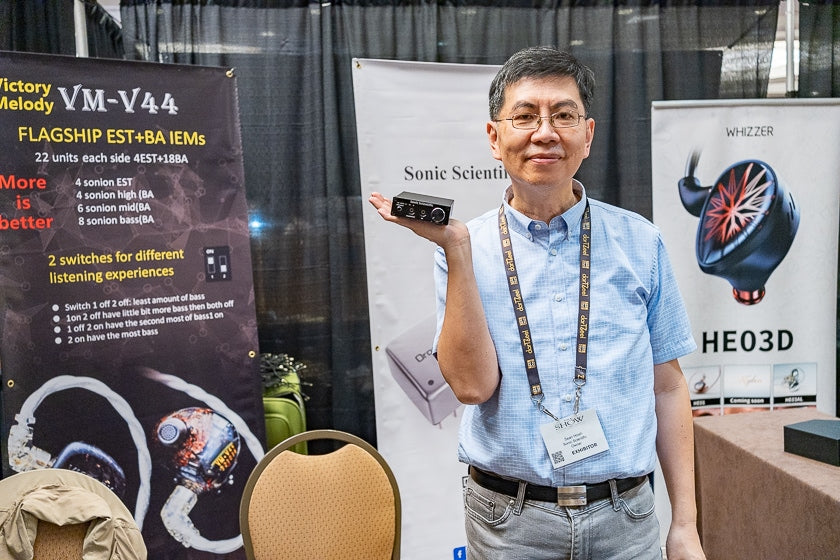
Sean Hsieh of Sonic Scientific, in T.H.E. Marketplace, holding his newly-released headphone amplifier.
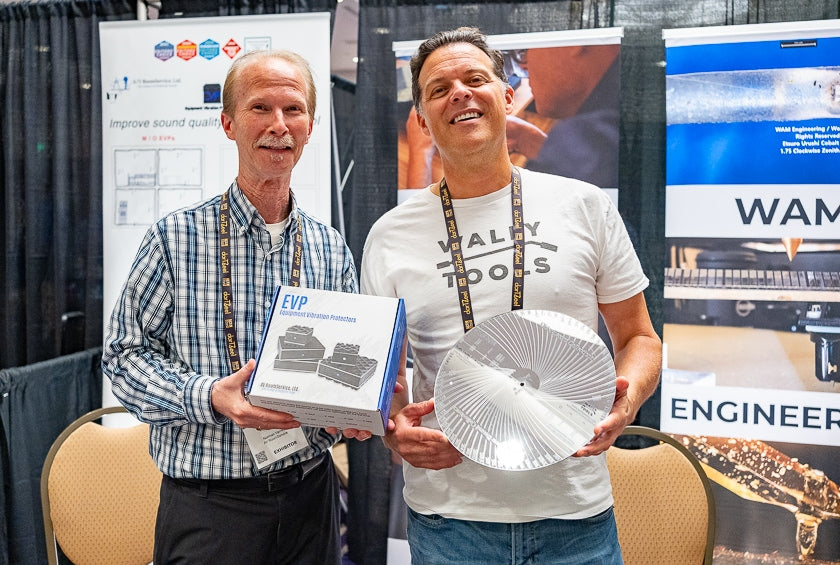
Norman Varney of A/V Room Service and J.R. Boisclair of WallyTools.
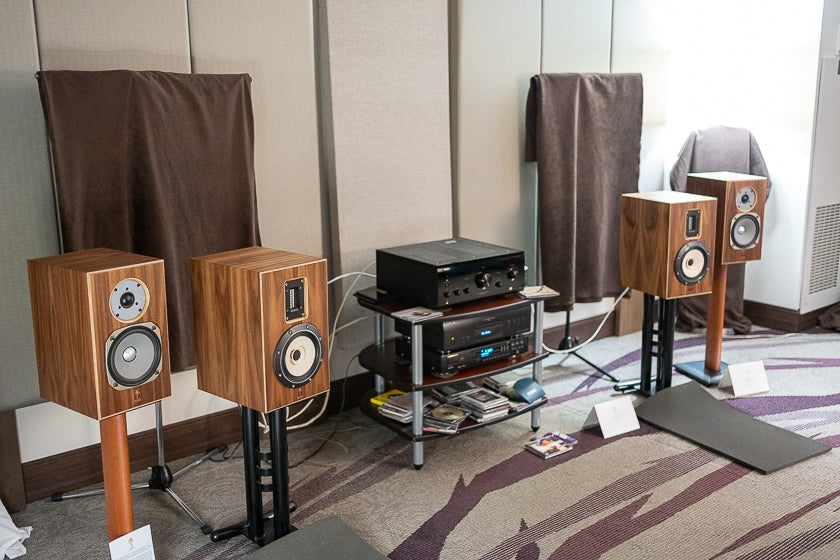
The Tonian Labs room, with Oriaco G6 EM speakers, and Denon and Marantz electronics.
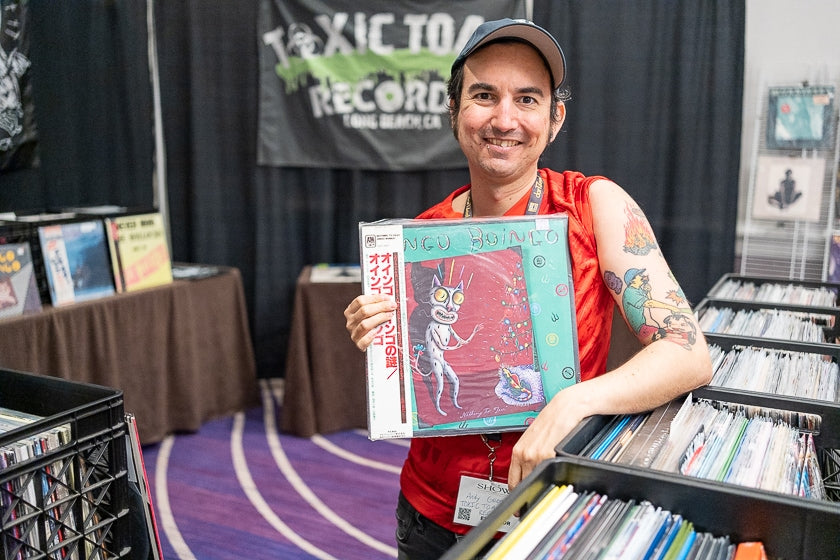
Andy George of Long Beach, CA vinyl vendor Toxic Toast Records had some great LPs for attendees to check out.
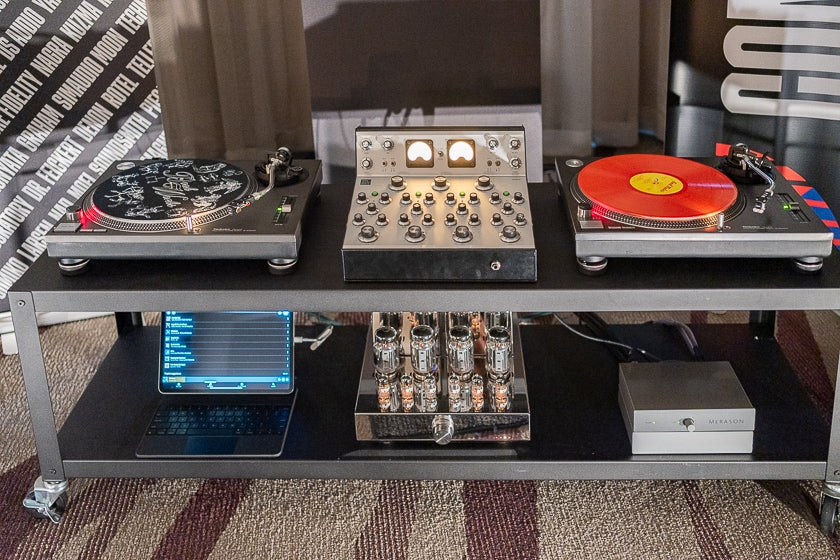
The Common Wave HiFi room. The Los Angeles audio dealer was showing a Technics SL-1210 MK II turntable, Varia Instruments RDM40 fully analog mixer, and a Merason DAC, among other products.
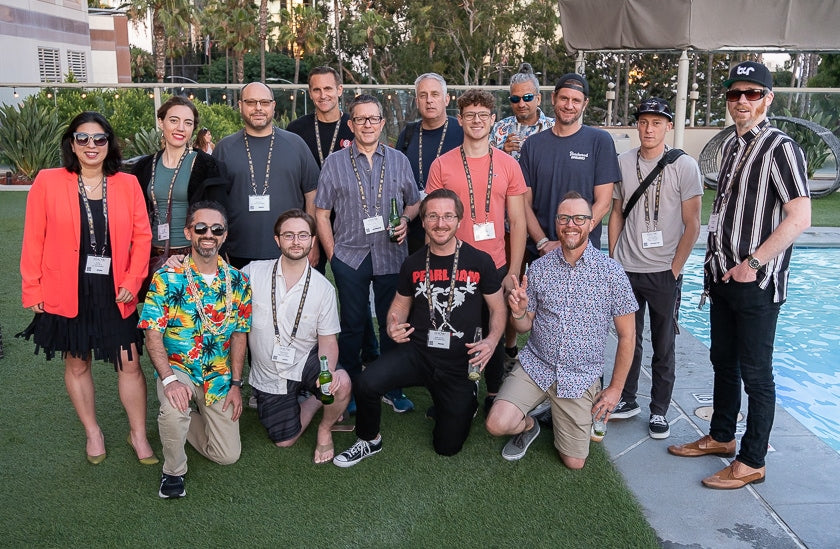
This photo is the result of an Instagram meetup. Most of the folks never met before this weekend, and all were Instagram friends after!
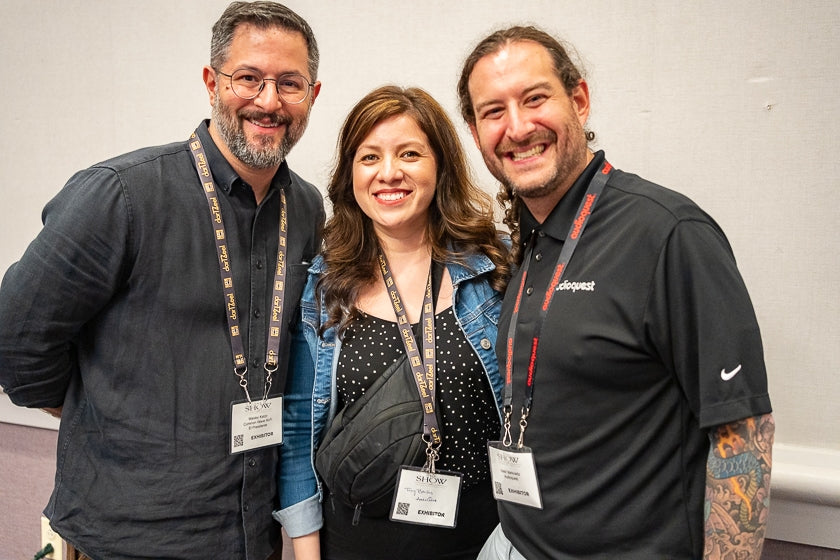
The power trio of Wesley Katzirn (Common Wave Hi-Fi), Tracy Barillas (AudioQuest), and Isaac Markowitz (AudioQuest).
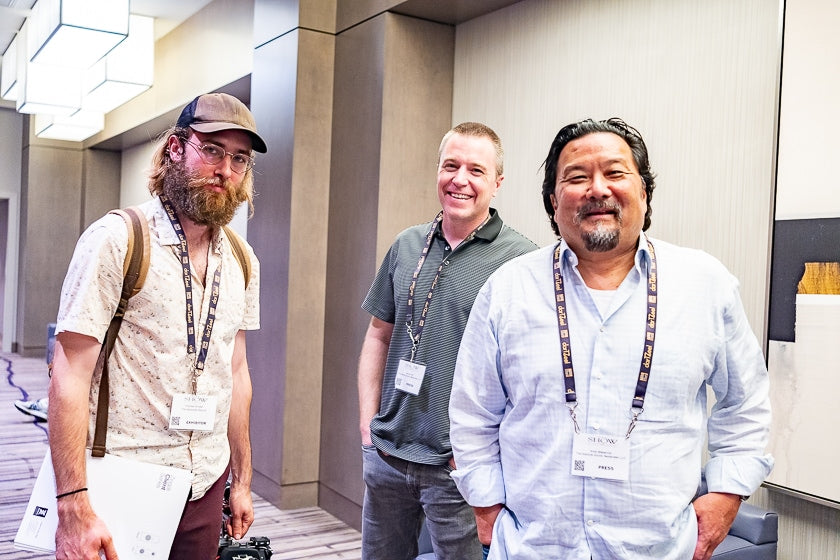
Fellow members of the hard-working press were in attendance, including Charles Kinder, Lance Profyt, and Brian Masamoto of The Absolute Sound.
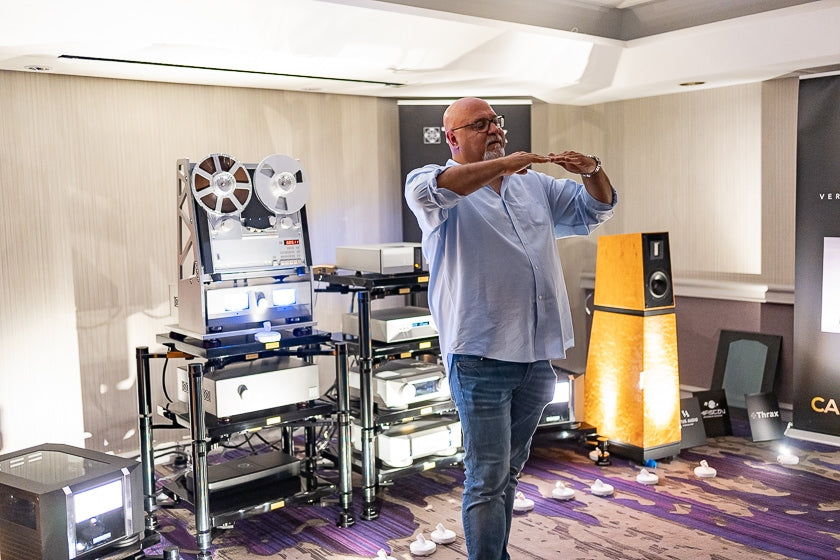
Oz Turan of High-End by Oz, holding court during one of his great after-hours reel-to-reel listening parties. This night was his birthday, so many attendees felt it would be rude not to sing to him, as well as make toasts.
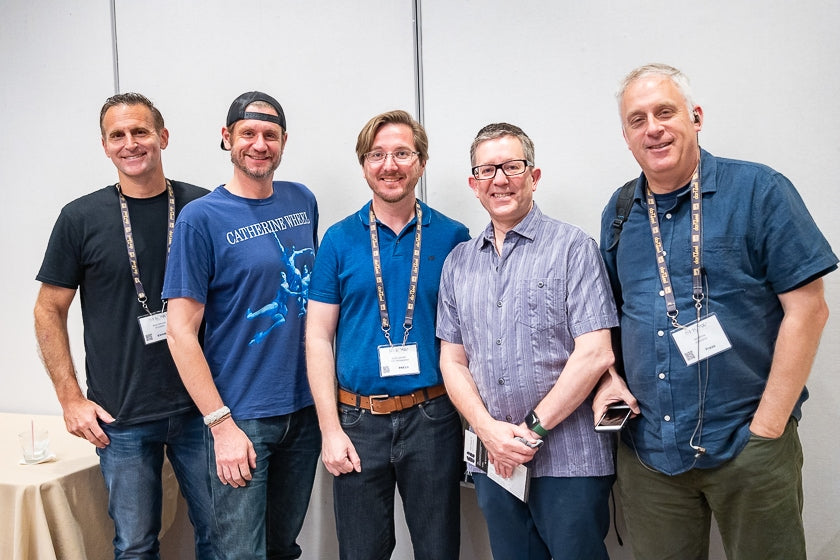
The eCoustics gang was in the town, including Brian Mitchell, Jeremy Sikora, T.H.E. ambassador Scott Lylander, Eric Pye, and Ian White.
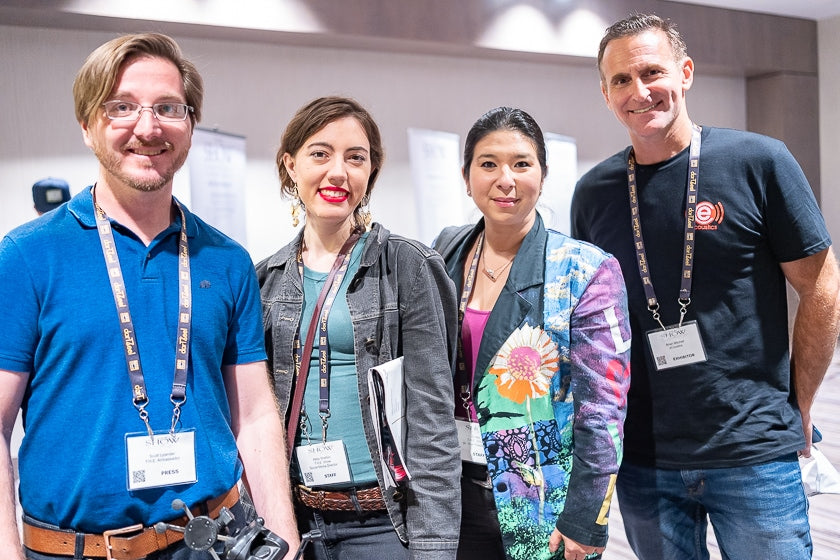
The folks who made the show happen: Scott Lylander, Abby Shelton (T.H.E. Show social media director), Emiko Carlin (T.H.E. Show senior vice president), and Brian Mitchell.
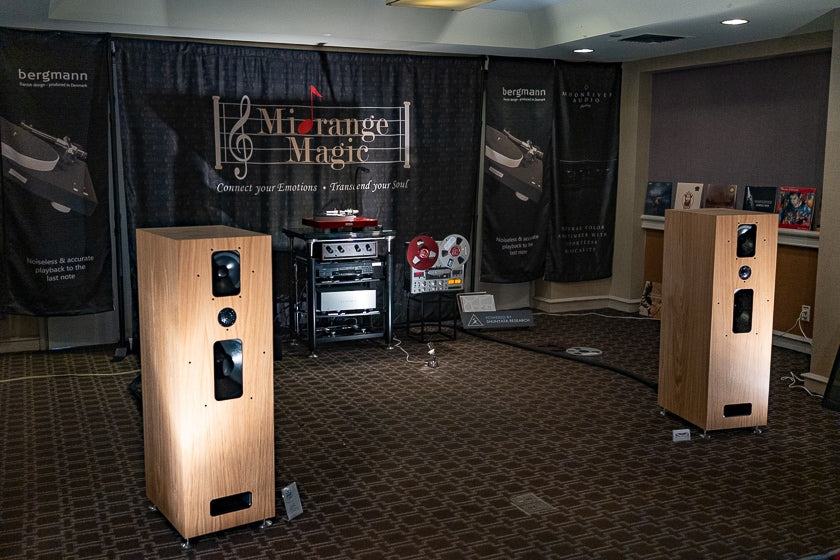
The British Audio Guys/On a Higher Note room was full of surprises, with components including the Bergmann Audio Modi turntable/Thor Arm/Hana ML cartridge, Moonriver Audio 404 Reference integrated amplifier, Shunyata Research Alpha V2 cables and Hydra Alpha power conditioner, Graham Audio LS5/5f speakers, custom SonoruS Revox PR99 tape machine, and an Artesania Audio rack.
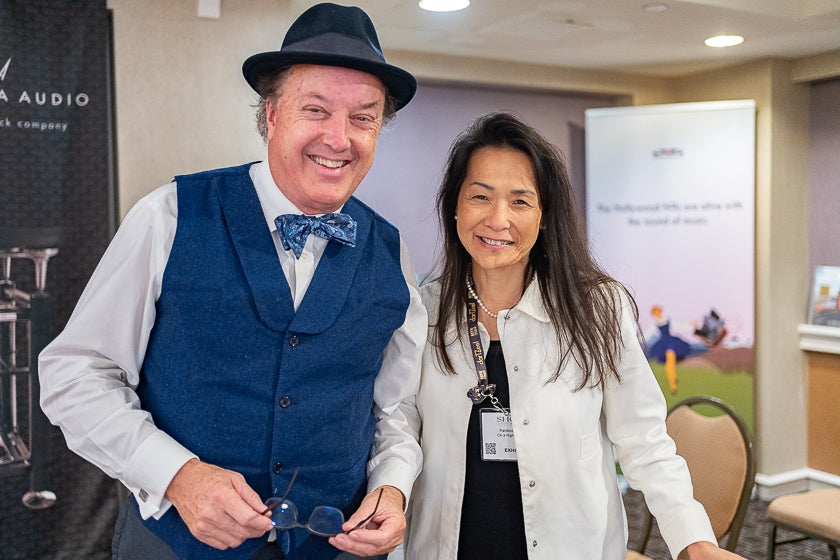
Philip O’Hanlon and Pandora Pang from On a Higher Note.
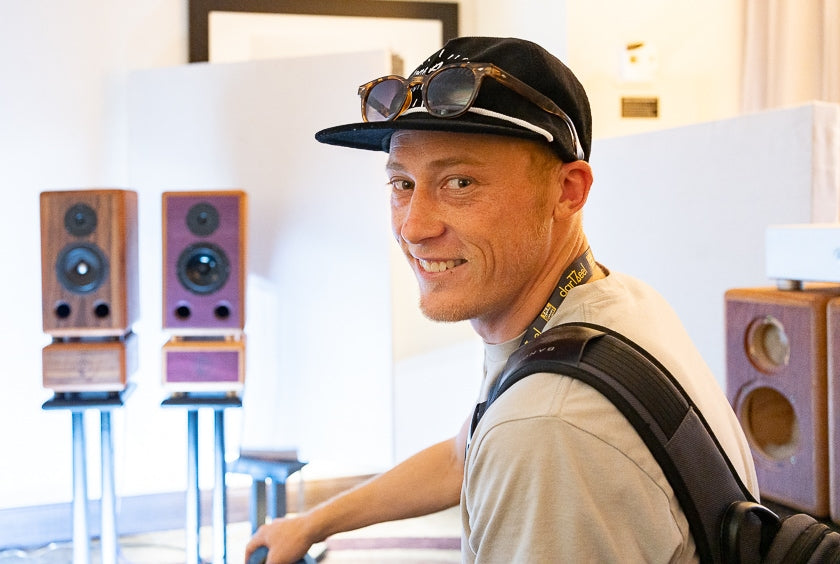
Nick Tamofsky of Black Ocean Audio. Nick’s room was one of the most talked about rooms. He had two versions of his Le Chiffre Studio speakers on hand.
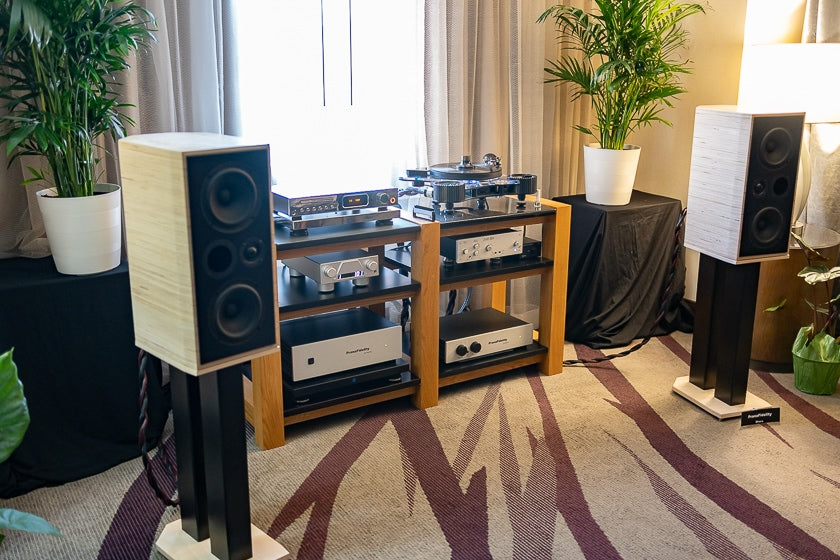
The PranaFidelity room was a favorite, featuring their Dhara speakers, and electronics.
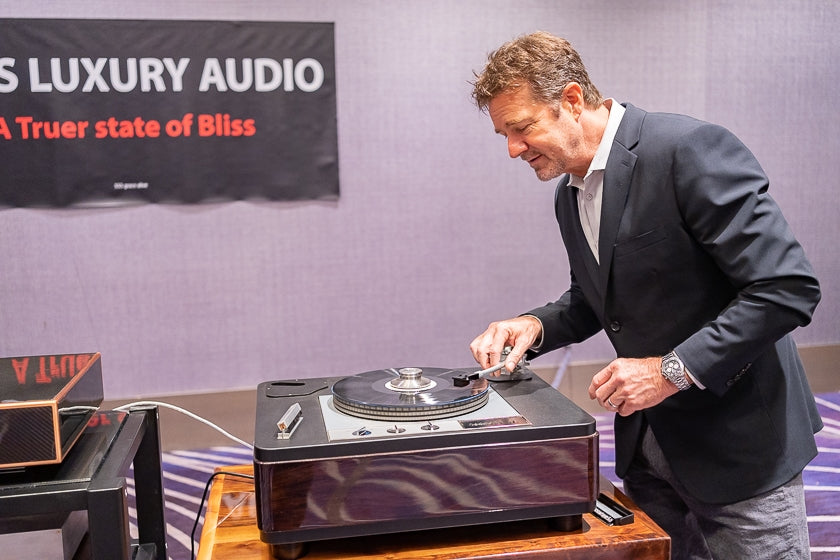
VOSS Luxury Audio’s John Voss demonstrates a PBN Garrard 401 turntable in a PBN GrooveMaster plinth, with a Grado cartridge. The room also featured a Voss SK MAGNUM OPUS amplifier, VITRA linestage preamp and Reference phono stage, and PBN M3!5 speakers.
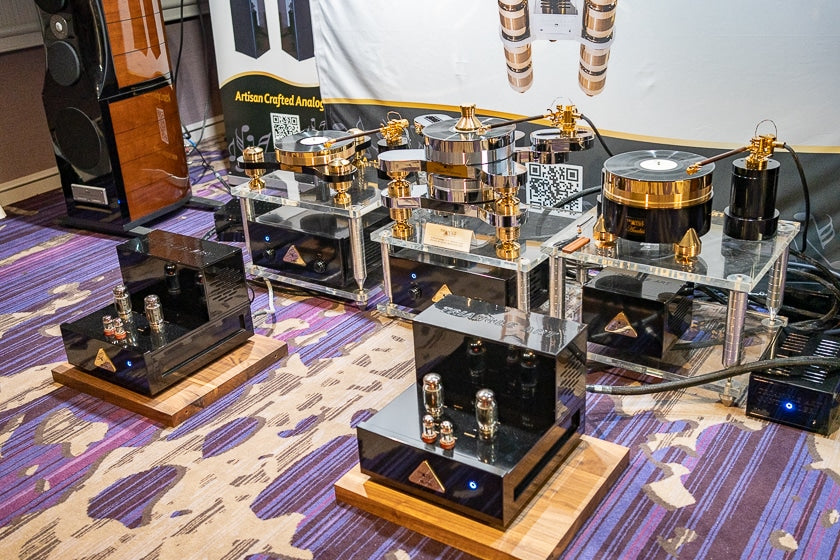
Pure dedication to turntables and vacuum tubes was represented in the TriangleART room, showcasing their Ultimate LE turntable, Metis horn loudspeaker, M-100 tube monoblock amplifier, L-200 preamp, and P-200 phono stage.
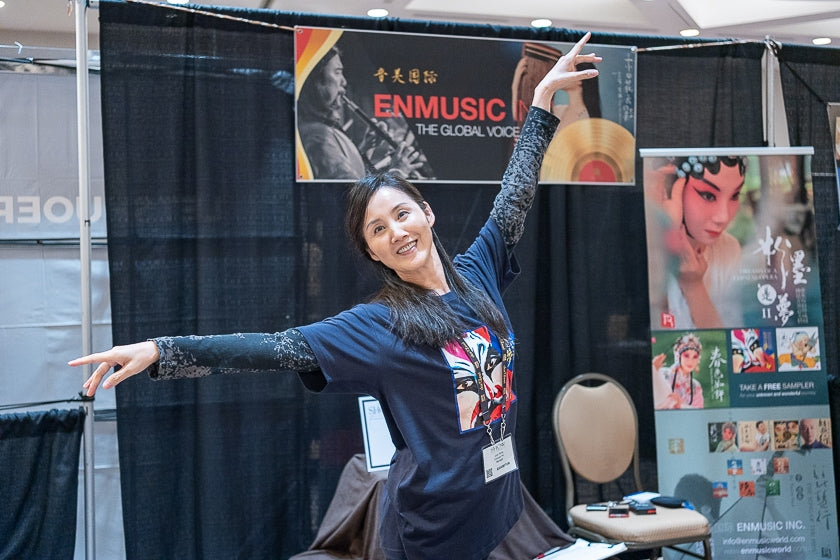
Judy Xiong of Enmusic Inc. providing the T.H.E. Music Marketplace with a ballet move few could pull off with such elegance, along with some excellent music.
This show report will be continued in the next issue.
Header image: Johnathan Ellis, president of Murrieta, California dealer Audio Chamber. All photos courtesy of Harris Fogel.

